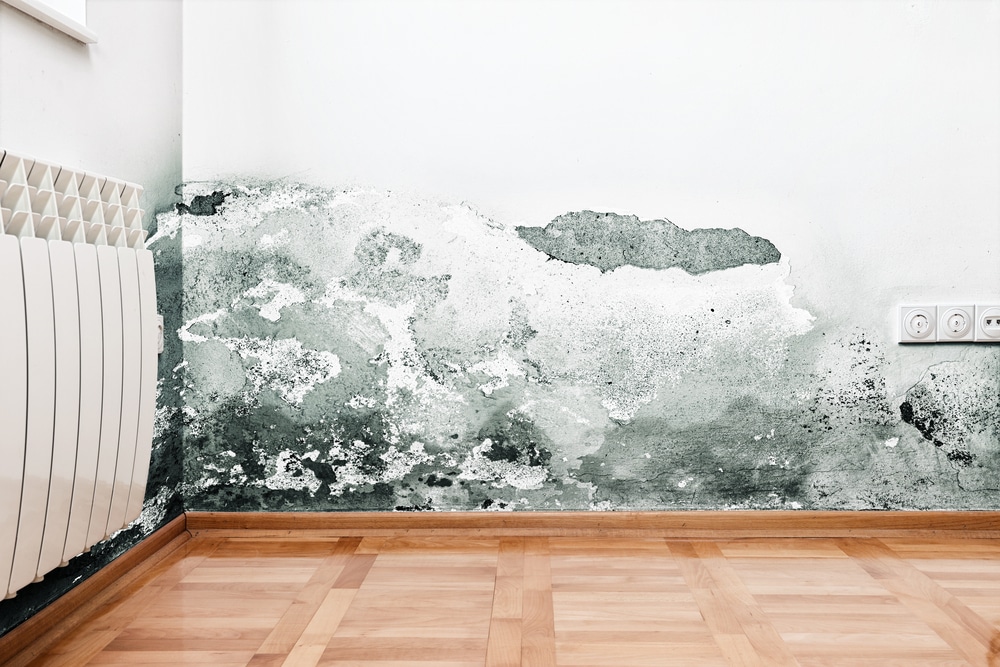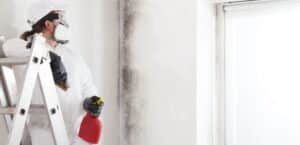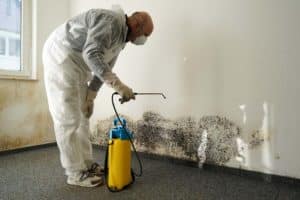If you’ve recently experienced a leak, flood, or plumbing issue, water damage and mold are significant concerns. When moisture is left sitting in your floors, walls, or ceilings, mold can start growing in as little as 24 to 48 hours.
It spreads fast and can lead to serious damage, not just to your home, but also to your health. The good news? If you’re facing water damage, you’re not alone. Our experts are here to help.
In this guide, we’ll walk you through the most common types of mold that appear after water damage, how to spot the warning signs, and what to do to protect your home and your health.
Table of Contents
Why Water Damage Often Leads To Mold Growth
Mold thrives in damp environments, which is why mold growth after water damage is a common problem. Whether it’s from a burst pipe, an overflowing sink, or a heavy storm, water can seep into your walls, floors, and ceilings, creating the perfect environment for mold to start growing.
Mold spores are always in the air, but they only become a problem when they land on wet or damp surfaces. If moisture isn’t dried quickly, mold can take hold fast.
Here’s why mold thrives after water damage:
- Moisture: Wet materials like wood, drywall, carpet, and insulation provide an ideal home for mold colonies.
- Poor ventilation: Warm, still air helps mold spread even faster.
- Hidden leaks: Water behind walls or under floors can stay hidden until mold appears.
Sometimes, you won’t even realize mold is growing until you smell that musty odor or see stains on your walls. That’s why acting fast after any water problem is crucial.
Experienced recent water damage? Cleanup & Total Restoration (CTR) has the resources and support to restore your home and prevent unsafe mold growth.
Common Types of Mold That Appear After Water Damage
Mold comes in many varieties, but some are more common from water damage than others. Each type has its own appearance, growth patterns, and risks. Knowing what to look for can help you spot mold early and get professional help before it becomes a bigger problem.
Here are the most common types of water damage mold:
Stachybotrys (Black Mold)
Often called “black mold,” Stachybotrys is one of the more well-known types you might encounter after water damage. It’s a greenish-black mold with a slimy texture when it’s wet.
- Grows on: Wood, drywall, paper, and insulation
- Thrives in: Areas that stay wet for long periods
- Health concerns: Can cause headaches, breathing problems, and fatigue.
If you think you have black mold, it’s best to call a professional for black mold removal right away. Trying to clean it yourself can make it spread and increase health risks.
Aspergillus
Aspergillus is one of the most common indoor molds. It also appears black with hints of other colors, such as green, white, or yellow, and often has a dusty or powdery look.
- Grows on: Walls, floors, HVAC systems, food
- Thrives in: Damp areas with low airflow
- Health concerns: Can trigger asthma, allergies, or more serious infections in people with weak immune systems.
Because it can spread easily and impact health, identifying and managing Aspergillus early is crucial.
Penicillium
Penicillium might remind you of the antibiotic penicillin, and that’s because this mold is actually where the drug comes from. But as water damage mold, it can cause serious problems. It spreads quickly and can easily transfer from one surface to another.
- Grows on: Carpets, mattresses, insulation, and wallpaper
- Thrives in: Cold or damp environments
- Health concerns: Can cause sinus infections and breathing difficulties.
If you notice signs of Penicillium, running your air conditioner or a dehumidifier can help slow its spread. However, if the problem worsens, it’s time to call in a professional.
Cladosporium
Unlike some molds from water damage that only grow in certain conditions, Cladosporium can thrive in both warm and cool environments. It’s found indoors and outdoors, usually appearing black or olive-green. This mold often grows alongside other common molds like Aspergillus and Penicillium.
- Grows on: Wood, HVAC vents, fabrics, and painted walls
- Thrives in: Moist areas, even if there isn’t standing water
- Health concerns: Can irritate the skin, eyes, and throat
If you spot Cladosporium in your home, it’s best to contact the professionals at Cleanup & Total Restoration (CTR) to inspect and handle it safely.
Signs of Mold Growth in Your Home
Mold after water damage is not always easy to spot. It hides behind walls, under carpets, or inside air ducts. The longer it goes unnoticed, the more it can spread and worsen after flood or stormwater damage.
But even when it’s out of sight, mold usually leaves behind a few warning signs:
- Musty or earthy smell that doesn’t go away
- Dark or discolored patches on walls, ceilings, or floors
- Peeling paint or wallpaper
- Warped or bubbled walls (especially near plumbing)
- Ongoing allergy-like symptoms such as sneezing, coughing, or itchy eyes
- Visible fuzz or spots in damp corners, around windows, or on stored items
- Increased humidity or condensation on windows and surfaces
If you’re seeing any of these warning signs, it’s a good idea to bring in a professional who can inspect the damage, confirm the source, and help prevent things from getting worse.
What To Do if You Spot Mold After Water Damage
Noticing mold after water damage in your home can feel overwhelming. But the good news is, quick action can make all the difference for your health and your home. And you don’t have to handle it alone. With the right professional help, mold can be contained, cleaned up, and kept from coming back.
Here’s what to do if you spot mold:
- Don’t touch or wipe the mold
Trying to clean it yourself can release mold spores into the air, making the problem worse and increasing health risks. - Shut off HVAC systems
Mold travels easily through vents. Turning off your heating or cooling system can help stop spores from spreading to other parts of your home. - Remove the source of moisture
Mold can’t survive without moisture. Whether it’s a leak or leftover flood water, it needs to be addressed quickly to stop new growth. - Call a certified mold remediation professional
This is the most important step. Mold removal requires the right tools, safety gear, and techniques to do the job right the first time.
Whether you’re dealing with a major water loss or just a slow leak, trust the caring and skilled team at Cleanup & Total Restoration (CTR). Our team is here to help contain mold and prevent further harm to your home and safety with expert mold remediation service.
When To Call Professional Help for Mold Removal
Not all mold requires professional cleanup, but water damage mold is a much bigger concern than the surface mold you might find in a shower or around a window.
In most cases, mold from a leak, flood, or plumbing issue isn’t just on the surface. It spreads quickly, hiding behind walls or under flooring, and can negatively impact your indoor air quality. That’s why knowing when to bring in the professionals is so important.
Here are a few signs it’s time to call a certified mold remediation specialist:
- The mold covers more than 10 square feet
- You can’t find or stop the moisture source
- Mold returns after you’ve cleaned it
- It’s growing inside walls, HVAC systems, or insulation
- Someone in your home has breathing issues or a weakened immune system
- You suspect black mold (Stachybotrys)
Professional mold remediation is about more than just removing visible mold. It also includes containment, air filtration, moisture control, and prevention strategies to keep it from coming back.
If your home has experienced stormwater damage or flood damage, it’s especially important to get an inspection. Hidden mold may already be present, even if you don’t see it.
Still unsure if it’s time to make the call? Take a look at these signs you need a mold remediation specialist for more guidance.
How Cleanup & Total Restoration Can Help With Mold and Moisture Issues
At Cleanup & Total Restoration, we understand how overwhelming mold and water damage can feel. But with the right team on your side, recovery doesn’t have to be complicated. Whether you’re dealing with visible mold or suspect it’s hiding behind the walls, we’re here to help from start to finish.
Our IICRC-certified technicians will inspect your property, identify the moisture source, and create a step-by-step plan to remove the mold and restore your home.
Here’s how we can help:
- Identify and eliminate the source of moisture
- Use advanced tools to detect hidden mold behind walls, floors, or ceilings
- Set up proper containment to keep mold from spreading
- Perform certified mold remediation using industry-standard safety protocols
- Restore your home to a clean, dry, and healthy condition
If you’ve had a leak, flood, or storm damage, let our experts guide you through the remediation and restoration process with expert care.











